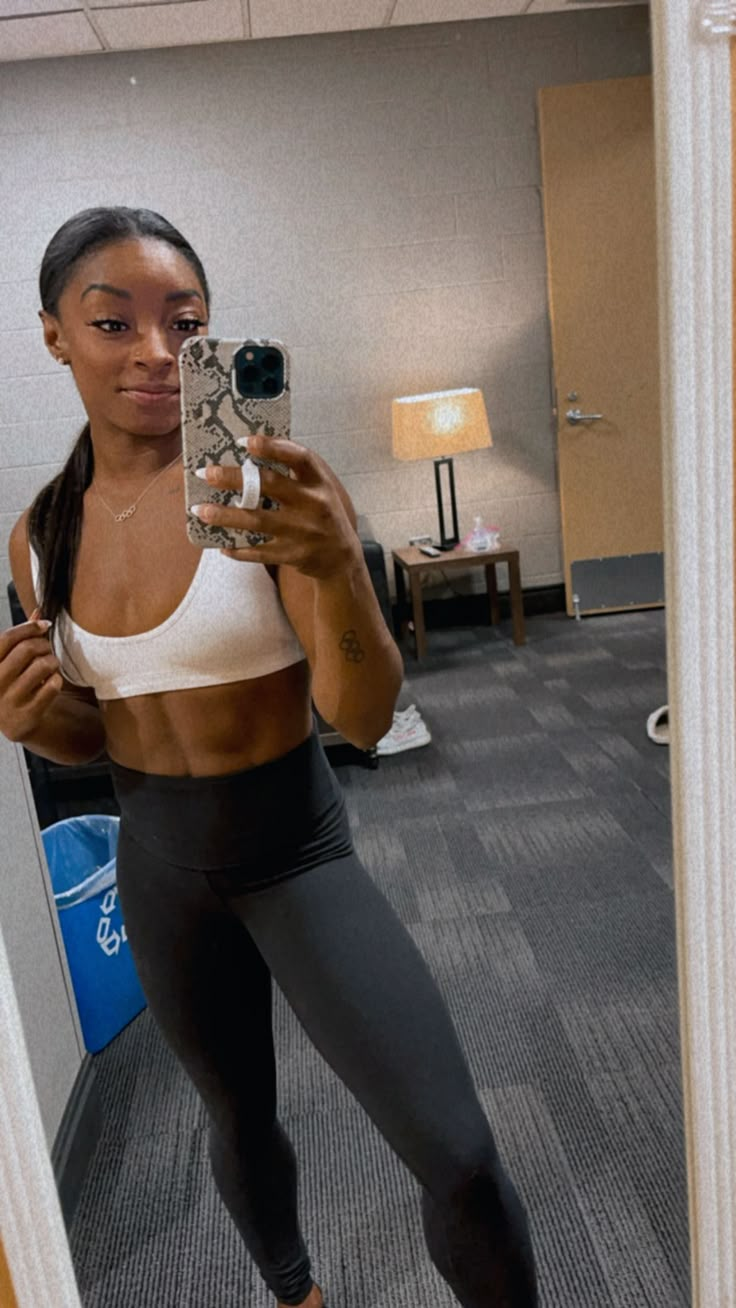
Simone Biles is getting candid about her plastic surgery experiences. The 11-time Olympic medalist casually shared in a recent TikTok that she’s had three plastic surgeries, including two that people wouldn’t notice. While the 28-year-old was coy in the video about what she’s had done, she later told People that she’s had breast augmentation, surgery to fix a tear in her ear, and a blepharoplasty (a.k.a. “bleph”), which is a surgical procedure done on the eyelids.
“I got a lower bleph because me and my family have, I call it the ‘Biles eye bags,’” she said. “We’ve just always had them, hereditary, and so that was just a big flaw. Every time I would go to a shoot, they’re like, ‘Oh, can we put some strips on her?’” Biles joked that she would get comments about her eyes, even when she had 12 hours of sleep the night before. “These are just hereditary, so it’s something that I wanted to fix,” she said.
When Olympic legend Simone Biles publicly revealed she underwent a lower blepharoplasty to correct hereditary under-eye bags, it sparked a fresh conversation about cosmetic surgery for younger adults. She didn’t do it for fame or vanity—she did it because it mattered to her. And in doing so, she shed light on a procedure many know little about. Whether you’re simply curious or seriously considering eyelid surgery, this article walks you through everything: what it is, why people do it, what you should ask, how the recovery works, and how to decide if it’s right for you. Let’s dive in.
What Is Lower Blepharoplasty?
Understanding the Procedure
“Blepharoplasty” is just a fancy word for eyelid surgery. When you see “lower blepharoplasty,” it refers to surgical correction of the lower eyelids—removing or repositioning excess fat, skin and sometimes muscle to reduce puffiness, under-eye bags or sagging.
Why It’s Becoming More Popular
You might think eyelid surgery is only for older people. Not so much anymore. According to experts, lower blepharoplasty was among the most common facial plastic surgery procedures in recent years. Younger adults, like Biles, are increasingly considering it—not just for aging signs, but for hereditary concerns or tired-looking eyes that don’t go away with sleep.
Why Simone Biles Chose It
Her Story
Simone shared that she and her family have what she called the “Biles eye bags” – hereditary under-eye puffiness that she felt always lingered, no matter how much sleep she got. Every time she’d go on a shoot someone would say: “Can we put some strips on her?” She wanted to fix something she felt stuck with.
Her Attitude Toward Surgery
What’s refreshing is how openly she approached it: not as a secret, but as a choice she made. She said she feels a responsibility to be transparent—especially for young women watching. She emphasized there’s no shame in the decision.
What That Means for You
Her openness helps remove some of the stigma around cosmetic surgery. If you’re struggling with something hereditary, or something that affects how you feel about yourself—even if it’s not “major”—you’re not alone. It also means the decision should be for you, not for anyone else.
Is Eyelid Surgery Right for You?
Common Reasons People Opt In
-
Hereditary under-eye bags or puffiness that don’t improve with sleep or skincare.
-
Sagging lower eyelid skin or fat bulges causing tired or heavy appearance.
-
Functional issues: sometimes excess skin droops enough to interfere with vision.
-
Desire for a refreshed, less fatigued look.
What It Isn’t
-
It’s not a substitute for good rest, diet, or skincare.
-
It’s not a guarantee of flawless “no-bags forever” status—skin still ages and genetics play a role.
-
It’s not purely “vanity” if it genuinely affects how you feel about yourself.
Self-Check Questions
Ask yourself:
-
Do I feel genuinely bothered by my under-eyes, even with good sleep and skincare?
-
Am I doing this for me—not because someone pressured me or I feel I have to?
-
Do I understand the risks, recovery, costs, and realistic results?
-
Is my overall health good enough for elective surgery?
If you answer yes to most of these, it might be worth exploring further.
The Procedure in Detail
What Happens on Surgery Day
According to experts: the actual surgery can be relatively quick—sometimes around 30 minutes per eye when it’s straightforward. Usually it involves local anesthesia and sometimes mild sedation. The surgeon designs incisions (often hidden just below the lash line or inside the lower eyelid), removes or repositions fat, removes excess skin, and re-contours the area.
Recovery Timeline
-
Days 1–3: Swelling and bruising are at their peak.
-
Week 1: Most people start to look like themselves again; bruising lessens.
-
Weeks 2–4: You can return to many normal activities (avoiding heavy lifting or strain).
-
3-6 months: Final results become clearer; lingering swelling may settle.
-
Full healing: Up to a year for everything to settle in.
Risks & Things to Ask
Any surgery has risks. For eyelid surgery these might include: infection, bleeding, asymmetry, dry eyes, changes in eyelid shape, visible scarring (though usually minimal). Before moving ahead, ask:
-
What’s the surgeon’s experience with lower blepharoplasty?
-
What techniques will they use (skin-only removal vs fat-repositioning)?
-
Can I see before & after photos of patients like me?
-
What is the realistic downtime and how will this impact my schedule?
-
What happens if I’m unhappy or need revision?
Cost, Maintenance & Expectations
Cost Considerations
The cost can vary widely depending on the surgeon, location, extent of procedure, anesthesia, facility fees, etc. Because of that, make sure you get a detailed quote. Also ask what’s included (post-op visits, garments, etc).
Maintenance & Longevity
For many patients, a lower blepharoplasty is a “one-and-done” kind of deal and doesn’t need frequent revisions. That said, the skin will continue aging, and new volume changes or sagging from aging may occur. Good skincare and sun protection help.
Setting Realistic Expectations
You will likely look refreshed, less tired-eyed, and more like you, but not dramatically different in a “you no longer look like yourself” way (unless you want that, but that’s a different approach). This is about enhancement, not reinvention.
Preparation & Aftercare Tips
Before Surgery
-
Choose a board-certified plastic surgeon or oculoplastic surgeon with experience in blepharoplasty.
-
Stop smoking, control any medical conditions (like high blood pressure).
-
Arrange for someone to drive you home and help the first night.
-
Avoid certain medications that increase bleeding risk (aspirin, some supplements) as advised.
-
Plan your downtime (often 1–2 weeks before social events).
After Surgery
-
Keep your head elevated, use cold compresses to reduce swelling in early days.
-
Use lubricating eye drops or ointment if dryness or irritation occurs (especially if you wear contacts).
-
Avoid strenuous exercise or heavy lifting for at least 2 weeks.
-
Attend follow-up appointments. Ask when you can use skincare or makeup again.
-
Be patient—full healing takes time.
Emotional & Psychological Considerations
Why Feelings Matter
Even though it’s a “minor” cosmetic surgery compared to some, it still involves your face—the part of you that the world sees. It’s normal to feel anxious, excited, or even second-guessing. Biles acknowledged this, saying that being open about her choices was important so others feel empowered.
Body Image & Social Media
In a world where “perfect” faces flood social media, it’s easy to feel less than. Biles pointed out that winning medals isn’t relatable to most people—but how we feel about our bodies, our insecurities, that is relatable. Remember: just because someone chooses surgery doesn’t mean you have to. The decision must be yours and yours alone.
Post-Procedure Reflection
After surgery, you may notice more than just physical changes—your confidence may shift, you might feel freer, or even experience unexpected emotions (relief, vulnerability, or even questioning the decision). Take time to adjust. Think of the change like upgrading your car: the model is the same you, but you’ve improved the engine. You’re still you.
Common Questions People Ask
Will I look “weird” or “different”?
Not if the surgeon is skilled. Good blepharoplasty results aim to preserve the natural shape of your eyes while improving the tired, baggy look. Over-correction or aggressive changes cause the “weird” look, so choosing a qualified specialist matters.
How long until I can return to work or go out?
Most people are back to non-strenuous work within a week or so; by two weeks they often feel socially presentable. But heavy exercise or contact sports may need more time.
Will the results last forever?
You will definitely age less around the lower eyes, but you will still age. New fat, skin laxity or genetics may make you consider touch-ups years later—but many people never need them.
What if I still have under-eye bags afterwards?
If you have residual puffiness, it may be due to underlying genetics, fat repositioning that wasn’t enough, or lifestyle factors. Talk to your surgeon about whether revision or adjunct treatments (like fillers) make sense.
Is surgery the only option?
No. For mild under-eye bags, non-surgical options (laser, fillers, creams) may help. But when the bags are structural (fat bulges, loose skin), surgery often gives the best long-term results. Biles clearly had hereditary bags that didn’t go away with sleep or skincare.

Final Words: Should You Consider It?
If you’ve read this far, you’re already doing the important part: inquiring, thinking, reflecting. Here’s how to wrap it up:
-
Make sure your why is clear. Wanting to feel more like yourself—not chasing someone else’s ideal—is key.
-
Choose a trusted, experienced surgeon and ask all your questions.
-
Understand downtime, cost, recovery, and emotional impact.
-
Recognize that this is an enhancement, not a fix for everything.
-
Be patient with your body as it heals.
Just like Simone Biles said: social media isn’t reality, and you get to decide what’s true for your body.
Conclusion
Eyelid surgery—especially lower blepharoplasty—is no longer a “crazy idea” reserved for later in life. As Simone Biles’ honest reveal shows, even someone who stands on podiums around the world can struggle with hereditary under-eye bags, and choose to address them on her terms. If you’re considering it, you’re not chasing perfection—you’re seeking confidence, comfort, and a version of you that feels aligned with your identity. Take your time, ask the right questions, and make the choice that feels right for you.
